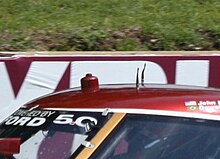RaceCam


RaceCam is a
History
Although a vehicle-mounted 16mm motion picture camera was used as early as 1973, the technology was first developed in the late 1970s by the Seven Network in Australia, who introduced it for the 1979 Hardie-Ferodo 1000 endurance race at Mount Panorama in Bathurst, New South Wales with Sydney-based driver Peter Williamson able to give commentary from his Toyota Celica.[1]
RaceCam in Australia was unique in that the drivers were often wired for sound and able to converse with the television commentary team during races with top touring car drivers such as Dick Johnson, Allan Grice, Peter Brock and later Glenn Seton, Jim Richards, Mark Skaife, Wayne Gardner and Channel Seven's own commentator turned racer Neil Crompton all becoming regular users of the system. RaceCam (with drivers doing their own commentary) became a staple of Seven's Australian Touring Car Championship and Bathurst 1000 broadcasts during the 1980s and 1990s.[2]

Over the years, the camera location varied from "over-the-shoulder" in 1983, to rear-mounted (looking backwards) in 1988, nosecone-mounted in 1994, and rollbar/above-mounted in 1997. Later, the above-mounted cameras were improved to be able to rotate 360°. Other camera views have included the rear wing (just above the rear tyre), the
In the same time-frame, CBS and ESPN began using on-board cameras during NASCAR telecasts from different developers. The large, boxy interior of the NASCAR stock cars allowed modified, nearly regular-sized video cameras to be mounted in the cockpit. CBS used a remote controlled, 360° rotating camera, and 1984 Daytona 500 winner Cale Yarborough carried one to victory.
While Racecam units had become common place in NASCAR, unlike in Australian touring car racing the drivers generally refused to be wired to talk to the television commentators while driving, saying that it was too distracting. In a NASCAR first, at the
Over the years, RaceCam has been refined and led to further developments. Besides the natural upgrades for high-definition television, the "Bumpercam" uses a camera mounted on the car's bumper. The "Roofcam" is a camera mounted on a car's roof, which gives a broader view, and a more authentic perspective of the driver's sightlines. Both systems are popular with NASCAR viewers. "Clearview" is another system, which removes grit and dust from the lens.
In IndyCar, all cars in the field are equipped with multiple "camera pod" housing units - one each above the roll bar, one embedded within the front nosecone, one in the aeroscreen, and in previous season, one the rear wing, and inside one of the rear-view mirrors - regardless if they are actually carrying cameras in those locations. This rule is such that cars carrying cameras will not have an aerodynamic disadvantage (or advantage) compared to cars not carrying cameras. In addition, camera-less cars carry equivalent ballast in place of the cameras, to ensure all cars have equal weight characteristics.
Driver's Eye
In 2019, the
References
- ^ "IP Australia". ipaustralia.gov.au. Archived from the original on 2011-03-27. Retrieved 2011-03-27.
- ^ Peter Brock describes a lap of Bathurst 1986
- ^ 1989 Banquet 300 - Dick Johnson Crash
- ^ "FIA Homepage - FIA Formula One Regulations". Fia.com. Archived from the original on 2006-05-02. Retrieved 2011-03-27.
- ^ "'Movement, vibration, dynamism': The helmet-cam that is revolutionizing Formula E". CNN. 19 February 2020.
- ^ "All the BEST From DRIVER'S EYE!". Formula E on YouTube. 22 March 2020.
- ^ "Racing Force Group on LinkedIn". Racing Force Group on LinkedIn. Retrieved 28 February 2023.
- ^ "Driver's Eye camera to become even more widely available in 2023". GP Blog. 23 January 2023.
